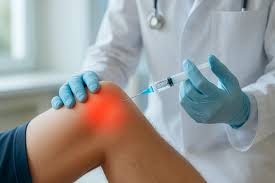Platelet-rich plasma (PRP) therapy has emerged as a regenerative treatment option for individuals experiencing knee pain. This procedure uses concentrated platelets from the patient’s own blood to potentially support the body’s natural healing processes. Understanding how PRP therapy works and its applications for knee pain can help patients make informed decisions about their knee pain treatment options.
Understanding PRP Therapy
Knee pain treatment sometimes includes PRP therapy, which involves extracting a small amount of blood from the patient, typically from the arm. The blood undergoes processing in a centrifuge machine, which separates the different components. This process concentrates the platelets, creating a plasma solution with platelet levels significantly higher than normal blood levels.
Platelets contain growth factors and proteins that play a role in the body’s natural healing response. When injected into the knee joint or surrounding tissues, PRP delivers these concentrated platelets directly to the treatment area. The procedure takes place in a medical office setting and typically requires 60 to 90 minutes from blood draw to injection. The injection itself uses ultrasound or other imaging guidance to target specific areas within the knee. This precision allows healthcare providers to deliver the PRP solution to locations where healing support may be most beneficial.
Identifying Useful Applications
PRP therapy addresses various knee-related conditions that cause pain and discomfort. Osteoarthritis represents one of the applications, as this degenerative joint condition affects people worldwide. The treatment targets the cartilage breakdown and inflammation associated with arthritis.
Tendon injuries, including patellar tendonitis and other forms of tendinopathy, also receive PRP treatment. These conditions involve damage to the connective tissues around the knee joint. Ligament injuries, such as mild to moderate strains, represent another category where PRP therapy finds application.
Meniscus tears, particularly partial tears that don’t require surgical intervention, may also benefit from PRP treatment. The meniscus serves as cartilage that cushions the knee joint, and tears can cause significant pain and mobility issues.
Muscle strains around the knee area, including quadriceps and hamstring injuries, represent additional conditions where PRP therapy may provide benefits. These soft tissue injuries often respond well to regenerative treatments.
Exploring the Recovery Process
The recovery timeline following PRP therapy varies among patients and depends on the specific condition being treated. Most patients experience some soreness at the injection site for 24 to 48 hours following the procedure. This discomfort typically resembles muscle soreness and can be managed with rest and ice application.
Activity modification becomes necessary during the initial recovery period. Patients usually avoid high-impact activities for several days to weeks, depending on their specific condition and treatment goals. Walking and gentle movement typically resume within a few days, while more strenuous activities require longer recovery periods.
Some patients notice improvements within a few weeks, while others may require several months to experience the full benefits of treatment. The healing process occurs gradually as the concentrated platelets work within the treated tissues. Multiple treatments may be recommended, with sessions typically spaced several weeks apart. The number of treatments depends on the severity of the condition, the patient’s overall health, and their response to the initial treatment.
Get Knee Pain Treatment
PRP therapy represents one option among various treatment approaches for knee pain. Patients should discuss their specific condition, medical history, and treatment goals with qualified healthcare providers to determine the most appropriate course of action. The procedure’s effectiveness varies among individuals, and results cannot be guaranteed. Factors such as age, overall health, activity level, and the specific nature of the knee condition all influence treatment outcomes. Understanding these variables helps set realistic expectations for the recovery process.









Leave a Reply